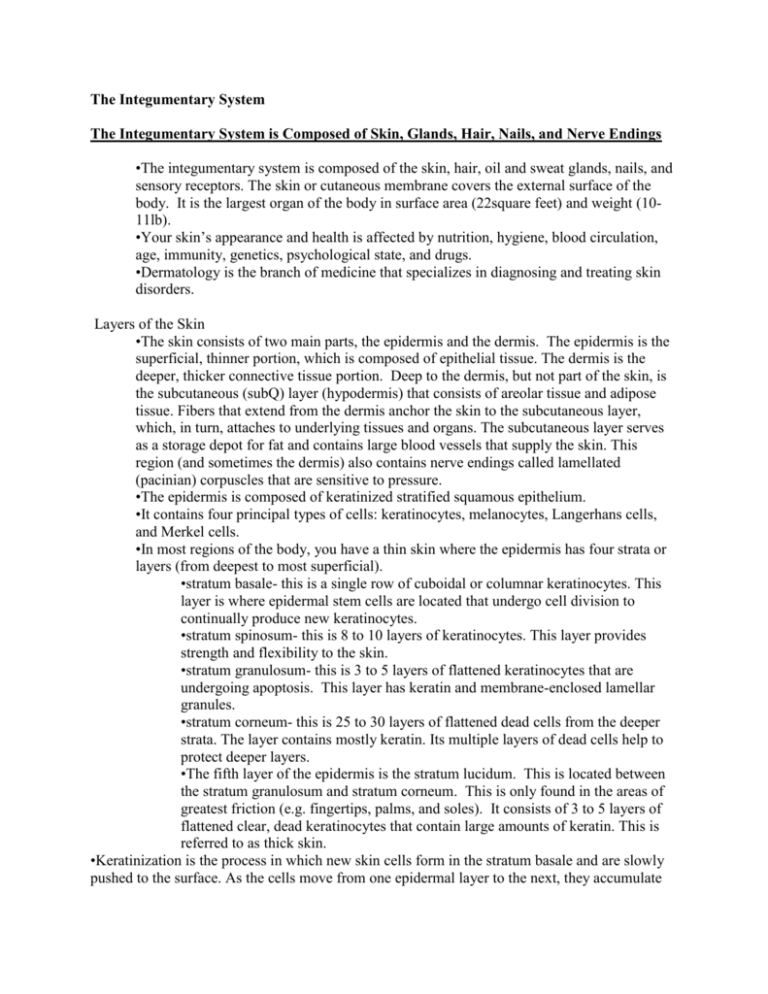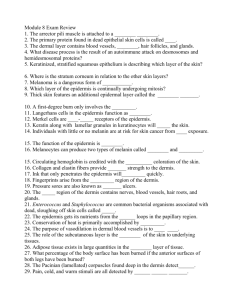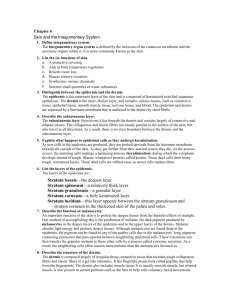Skin outline/study guide - Southington Public Schools
advertisement

The Integumentary System The Integumentary System is Composed of Skin, Glands, Hair, Nails, and Nerve Endings •The integumentary system is composed of the skin, hair, oil and sweat glands, nails, and sensory receptors. The skin or cutaneous membrane covers the external surface of the body. It is the largest organ of the body in surface area (22square feet) and weight (1011lb). •Your skin’s appearance and health is affected by nutrition, hygiene, blood circulation, age, immunity, genetics, psychological state, and drugs. •Dermatology is the branch of medicine that specializes in diagnosing and treating skin disorders. Layers of the Skin •The skin consists of two main parts, the epidermis and the dermis. The epidermis is the superficial, thinner portion, which is composed of epithelial tissue. The dermis is the deeper, thicker connective tissue portion. Deep to the dermis, but not part of the skin, is the subcutaneous (subQ) layer (hypodermis) that consists of areolar tissue and adipose tissue. Fibers that extend from the dermis anchor the skin to the subcutaneous layer, which, in turn, attaches to underlying tissues and organs. The subcutaneous layer serves as a storage depot for fat and contains large blood vessels that supply the skin. This region (and sometimes the dermis) also contains nerve endings called lamellated (pacinian) corpuscles that are sensitive to pressure. •The epidermis is composed of keratinized stratified squamous epithelium. •It contains four principal types of cells: keratinocytes, melanocytes, Langerhans cells, and Merkel cells. •In most regions of the body, you have a thin skin where the epidermis has four strata or layers (from deepest to most superficial). •stratum basale- this is a single row of cuboidal or columnar keratinocytes. This layer is where epidermal stem cells are located that undergo cell division to continually produce new keratinocytes. •stratum spinosum- this is 8 to 10 layers of keratinocytes. This layer provides strength and flexibility to the skin. •stratum granulosum- this is 3 to 5 layers of flattened keratinocytes that are undergoing apoptosis. This layer has keratin and membrane-enclosed lamellar granules. •stratum corneum- this is 25 to 30 layers of flattened dead cells from the deeper strata. The layer contains mostly keratin. Its multiple layers of dead cells help to protect deeper layers. •The fifth layer of the epidermis is the stratum lucidum. This is located between the stratum granulosum and stratum corneum. This is only found in the areas of greatest friction (e.g. fingertips, palms, and soles). It consists of 3 to 5 layers of flattened clear, dead keratinocytes that contain large amounts of keratin. This is referred to as thick skin. •Keratinization is the process in which new skin cells form in the stratum basale and are slowly pushed to the surface. As the cells move from one epidermal layer to the next, they accumulate more and more keratin. Eventually, the keratinized cells slough off and are replaced by underlying cells. This cycle from cell division to sloughing off takes about four weeks in an average epidermis. •The dermis is second, deeper part of the skin. It is composed mainly of connective tissue containing collagen and elastic fibers. The superficial part of the dermis consists of areolar connective tissue containing fine elastic fibers. Its surface area is greatly increased by small, fingerlike projections called dermal papillae. The dermal papillae contain: •Blood capillaries (capillary loops) •Touch receptors (corpuscles of touch or Meissner corpuscles) -nerve endings that are sensitive to touch. •Free nerve endings - associated with sensations of warmth, coolness, pain, tickling, and itching. •The deeper part of the dermis, which is attached to the subcutaneous layer, consists of dense irregular connective tissue containing collagen and elastic fibers and interspersed with adipose cells, hair follicles, nerves, oil glands, and sweat glands. This structure provides the skin with strength, extensibility, and elasticity. Skin Color •Skin colors are produced by three pigments, melanin, hemoglobin, and carotene. • The amount of melanin, which is produced by melanocytes, causes a variety of skin color. Melanocytes are most plentiful in the epidermis of the penis, nipples of the breasts, areas just around the nipples (areolae), face, and limbs. The number of melanocytes is about the same in all people. The differences in skin color are due mainly to the amount of melanin produced and the transfer to keratinocytes. •Dark-skinned individuals have large amounts of melanin in the epidermis. Lightskinned individuals have little melanin in the epidermis. •Hemoglobin, the oxygen-carrying pigment in red blood cells, will also help determine the color of skin. •Albinism is an inherited trait where individuals do not produce melanin. People affected by albinism (albinos) do not have melanin in their hair, eyes, and skin. •Melanin and melanocytes may not be evenly distributed throughout the skin: •Freckles – melanin accumulates in patches. •Age (liver spots) – melanin accumulates in areas with age that form flat blemishes, which look like freckles, but range in color from light brown to black. •Nevus (mole) - a round, flat, or raised area that represents a benign localized overgrowth of melanocytes and usually develops in childhood or adolescence. •Vitiligo is a condition where melanocytes are partially or completely lost from areas of the skin, thereby producing irregular white spots. •Melanin levels in the skin change upon exposure to sunlight. UV light stimulates melanin production, which increases both the amount and darkness of melanin. •Carotene is a yellow-orange pigment. This accumulates in the stratum corneum and fatty areas of the dermis and subcutaneous layer in response to excessive dietary intake. Too much carotene may turn the skin an orange color. Decreasing carotene intake eliminates the problem. Accessory Structures Provide Protection and Help Regulate Body Temperature •Hair, glands, and nails, develop from the epidermis of the embryo. Each performs important functions in the body. Hair •Hairs (pili) are present on most skin surfaces except the palms, palmar surfaces of the fingers, soles, and plantar surfaces of the toes. •The thickness and pattern of distribution of hair is largely determined by genetic and hormonal influences. •Hair is protective. •Each hair is fused, dead, keratinized epidermal cells that consists of the following: •Shaft is the superficial portion that projects above the surface of the skin. •Root is the portion below the surface that penetrates into the dermis. •Hair follicle surrounds the root and is composed of external and internal root sheaths surrounded by a connective tissue sheath. •Hair root plexuses are nerve endings that surround each hair follicle. •Bulb is the base of each follicle. The papilla, located within bulb contains blood vessels. The hair matrix, located within the bulb, produces new hairs by cell division. •Associated with each hair are sebaceous (oil) glands and a bundle of smooth muscle cells (arrector pili). When arrector pili muscles contract, it pulls the hair shafts perpendicular to the skin surface. •The color of hair is due to melanin, which is produced in the hair matrix. •Scalp and body hair grow continuously throughout most of your life. However, at puberty, hormones stimulate a different type of hair growth as well: •In males, the release of androgens will promote the male pattern of hair growth, including a beard, chest, and axillary. In females, androgens will promote hair growth in the axillae and pubic region. •A tumor of the adrenal glands, testes, or ovaries produces an excessive amount of androgens which results in a condition of excessive body hair (hirsutism). •Androgenic alopecia (male-pattern baldness) is genetically predisposed condition in adults in which adrogens inhibit hair growth producing baldness. Glands •Sebaceous glands secrete oily sebum that softens skin, prevents hair from drying out, and prevents water from evaporating. Blackheads are an accumulation of sebaceous glands of the face. •Sudoriferous glands are sweat glands. They are composed of eccrine and apocrine sweat glands. •Ceruminous glands are found in the ear canal and outer ear. They secrete earwax (cerumen) which prevents foreign objects and insects from entering the ear, waterproofs the ear canal, and prevents bacteria and fungi from entering the ear. Nails •Nails are plates of tightly packed, hard, dead, keratinized cells of the epidermis. Each nail consists of a nail body, nail root, and nail matrix. •The average growth of fingernails is about 1mm (0.04 inch) per week. •The nail body is pink because of the blood vessels of the underlying skin. The free edge is white because it extends past the tip of the finger or toe and there is no underlying tissue. The lunula is white because the nail is too thick in this region for any blood vessels to show through. •Functionally, nails help us grasp and manipulate small objects, provide protection to the ends of the fingers and toes, and allow us to scratch various parts of the body. The Skin Plays a Number of Roles in Body •The following are functions of the skin •Regulate your body temperature •Acts as a large reservoir of blood •Protective barrier for the internal organs •Keratin protects the body from heat, abrasion, chemicals, and microbes •Houses a number of types of sensory receptors •Absorbs and secretes substances •Plays a role in calcium homeostasis and produces vitamin D •Any or all of the functions of the skin may be disrupted when the skin gets severely damaged. •The more tissue that is damaged, the less likely it will be that the skin can repair itself. Severe and extensive injuries to the skin, like burns, can be life-threatening due to circulatory consequences and/or bacterial infection. Skin Cancer and Aging •Most age-related changed in skin do not occur until people reach their late forties. •Protein fibers in the dermis stiffen and break down leading to wrinkles •The numbers of various cell types decrease leading to diminished immune responses, graying hair, and age spots •Oil gland secretions diminish leading to dry, broken skin that is prone to infection •Hair loss occurs and hair growth slows •Skin becomes thin and heals poorly •Nails grow slower and become brittle •Besides age, excessive exposure to the sun causes damage to the skin and skin cancer. UVA rays are absorbed by sun tanning and depress the immune system. UVB rays can cause sunburn and produce wrinkles. Both UVA and UVB damage skin cell DNA and contribute to skin cancer. •Basal cell carcinoma (78% skin cancers) – tumors arise from cells in the stratum basale of the epidermis and rarely metastasize. •Squamous cell carcinoma (20% skin cancers) – tumors arise from squamous cells in the epidermis. They tend to arise from pre-existing lesions of sun-damaged skin. •Malignant melanoma (2% skin cancers) – tumors arise from melanocytes, metastasize quickly, and can kill a patient within months of diagnosis. •The major way to prevent skin cancer is to reduce exposure to the sun. Sunscreen lotions reduce the damaging effects of UV radiation.









